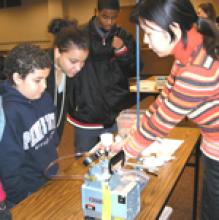
The goal of this demonstration is to show how a zeolite can work as a "cage" to trap certain molecules selectively.
Zeolite Procedure
Materials needed:
Microscale
- 1 Buchner Funnel
- 1 125 mL Filter Flask
- 1 Piece of Filter Paper
- 1Pump
- 1 Filter Adapter
- 125 g container of Zeolite
- 3 Vials
- 1/2 tsp Zeolite in one vial filled with water
- 1/2 Vial of Bipyridine
- 1/2 Vial Diluted Fe(Bipyridine) solution
- 3 Squirt Bottles
- 1 Blue Squirt Bottle w/ Water
- 1 Blue Squirt bottle with Cu(NH 3) 6
- 1 Red Squirt bottle with Diluted Iron Bipyridine
Macroscale
- Smaller plastic balls
- Larger plastic balls
- Plastic tub with wooden insert (with holes cut-out)
Procedure
Set-up
Microscale
- Check to make sure you have all the supplies.
- Set up pump, filter flask, adapter, and funnel with paper.
- Fill 1 vial halfway with Iron Bipyridine, a.k.a. Fe(Byp) (red solution.)
- Fill another vial halfway with the Cu(NH 3) 6, (blue solution.)
Set-Up
Macroscale
- Have all materials on the table.
The Demonstration: Microscale
- Point out that you have this neat white powder called a zeolite that has very interesting characteristics. This zeolite is actually in many commercial laundry detergents. You can get it by taking a cup of detergent, adding some water to dissolve most of the other ingredients and waiting for the zeolite to settle out.
- Show them the container with the zeolite. Put 1/2 teaspoon of zeolite into the third empty vial and fill with water. Put lid on vial have an audience member shake vigorously.
- Turn on the pump and wet filter paper. Pour zeolite mixture onto paper and rinse vial with water. Allow all of the water to be sucked through the filter.
- Show the red solution to the audience and try to get them to guess what will happen when you pour the red solution on the zeolite. Pour red solution (Fe(Byp)) onto the zeolite. Point out the water coming through the filter is clear and the zeolite is pink. Allow all of the solution to go through the filter.
- Show the blue solution to the audience and ask them to guess what will happen when you pour this solution over the zeolite. Pour Blue solution ( Cu(NH 3) 6 +2 ) onto the zeolite. Point out the water coming out is red now and the zeolite is blue.
- Explain that the zeolite has many tiny holes which trap the colored molecules in the water, but it likes to trap some molecules over others and therefore the blue solution takes the place of the red solution (it is selectively traps the blue molecules.)
The Demonstration: Macroscale
- Have visitors add larger red balls to the tub and shake them around. Show how they will stay in the holes. Ask the visitors what this is similar in the micro scale demo.
- Then ask a visitor to put in the smaller blue balls and get another visitor to shake. Ask them what this is similar to tin the micro scale version of the demo. Ask them what is going to happen. Which balls will be held in the holes? Then open the box to reveal the smaller blue balls in the holes, with the larger red ones lying loose on top.
Cleanup:
All solutions are safe for sink (sewer) disposal.
- Pour solutions from filter flasks down a sink.
- Throw away zeolite and filter paper.
- Rinse funnel and vials.
- Put filter set up back together for next demonstration.
- Gather all materials and return to storage.
Procedure Sheet: zeolite_procedure.pdf
Zeolite FAQs
A zeolite is a material (natural or synthetic) with a crystalline structure made up of silicon, aluminum, and oxygen in a regular pattern. These molecules act as a "cage" to trap certain molecules selectively.
Cool Facts:
- Natural zeolites are all around us, but we call them clays.
- Zeolites can trap molecules selectively by size. Large molecules fit in the cage, but smaller ones will go right through.
- Zeolites can trap molecules selectively by charge. Synthetic zeolites made with more aluminum prefer to trap +2 ions over +1 ions. Exactly how this works is unknown.
- QuikClot is a zeolite product being used by the army to stop uncontrolled bleeding. It selectively absorbs water, but leaves platelets to clot.
- Some zeolites can be used as catalysts in chemical reactions; they trap molecules together in a small cage so that they react together.
A: That information is proprietary. Zeolites are composed of Si, Al and O organized into a crystallized structure.
A: Natural zeolites are clays, formed from volcanic ash that has been exposed to alkaline conditions (ancient lakes). Synthetic zeolites can be made like any other crystals (e.g. those in a "grow your own crystal garden kit") through the nucleation of silicate/aluminate solutions.
A : This is not known. It is most likely due to size selection, charge selection or combination of the two. Size selection traps molecules that are the right size. Too big won't enter, but too small go right through. Charge selection traps +2 ions over +1 ions, and it is known the closer the Si:Al ratio is to 1, the more charge preference.
A: No, zeolites are negatively charged, and thus can trap only positive (or neutral) molecules. Negative ions (such as PO 4 3- or SO 4 3-) would be repelled.
Zeolite selectivity can be used to remove dangerous chemicals from waste waters (e.g. heavy metal cations and ammonia.) Some can even be used to trap radioactive ions! They can also be used to clean up the air when used in car exhaust systems to absorb VOC (organic particles), or catalyze the reduction of NO x.

